 |
From Wikipedia, the free encyclopedia
Benghazi
|
| Country |
 Libya Libya |
| Municipality |
Benghazi |
| Population (2005) |
650,629 |
| Area code(s) |
061 |
|
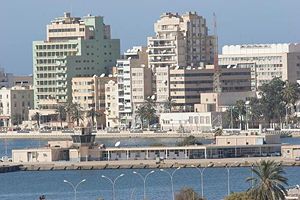
Buildings in the city centre |
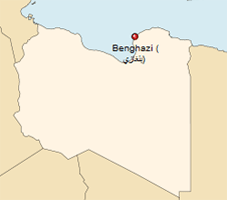
Location in Libya |
Benghazi or Bengasi is the second largest city in Libya and the main city (or capital) of the Cyrenaica region (or ex-Province). It is also a municipal territory of Libya of the wider city area. During the Kingdom era of Libya's history, Benghazi enjoyed a sort of joint-capital status (alongside Tripoli), possibly because the King used to reside in the nearby city of Al Bayda' and the Senussis (royal family) in general were associated with Cyrenaica rather than Tripolitania. Benghazi continues to hold institutions and organizations associated normally with a national capital city. This creates a constant atmosphere of rivalry and sensitivities between it and Tripoli and by extension between the two regions (Cyrenaica and Tripolitania).
Benghazi was originally founded around 6th century BC by Ancient Greeks and named "Euesperides" and few centuries later refounded by Ancient Egyptians and named "Barneek" (or "Berenice"). This later old name sounds similar to Cyrenaica's Arabic name ( , pronounced "Barqah", or Barca), so the city's old name might be related to the region's recent Arabic name. The city's present name, Benghazi, is derived from that of a pious benefactor of the city named Ghazi or "Sidi Ghazi," as the locals called him, who died about 1450. The city was renamed "Bani Ghazi" (which literally means Ghazi's sons or descendants). The population was 500,120 in 1995 (census) and has increased to 660,147 in the 2004 census (another 2004 estimate puts the number at 950,000, possibly due to the inclusion of a larger area of outskirts around the city). , pronounced "Barqah", or Barca), so the city's old name might be related to the region's recent Arabic name. The city's present name, Benghazi, is derived from that of a pious benefactor of the city named Ghazi or "Sidi Ghazi," as the locals called him, who died about 1450. The city was renamed "Bani Ghazi" (which literally means Ghazi's sons or descendants). The population was 500,120 in 1995 (census) and has increased to 660,147 in the 2004 census (another 2004 estimate puts the number at 950,000, possibly due to the inclusion of a larger area of outskirts around the city).
History
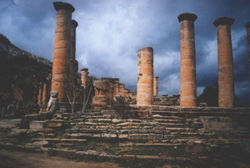 The Ancient city of Cyrene along with Berenice (Benghazi) formed Eastern Libya's pentapolis. The Ancient city of Cyrene along with Berenice (Benghazi) formed Eastern Libya's pentapolis.
Modern Benghazi, on the Gulf of Sidra, lies a little southwest of the site of the ancient Greek city of Berenice or Berenicis. That city was traditionally founded in 446 BCE (different sources give different dates like 347 BCE or 249 BCE), by a brother of the king of Cyrene, but got the name Berenice only when it was refounded in the 3rd century BCE under the patronage of Berenice (Berenike), the daughter of Magas, king of Cyrene, and wife of Ptolemy III Euergetes, the ruler of Egypt. The new city was later given the name Hesperides, in reference to the Hesperides, the guardians of the mythic western paradise. The name may have also referred to green oases in low-lying areas in the nearby coastal plain. Benghazi later became a Roman city and prospered for 600 years. The city superseded Cyrene and Barca as the chief center of Cyrenaica after the 3rd century CE and during the Persian attacks, but when the Arabs came, in 642-643, it had dwindled to an insignificant village among magnificent ruins.
In the 1200s, the small settlement became an important player in the trade growing up between Genoese merchants and the tribes of the hinterland. In 16th century maps, the name of Marsa ibn Ghazi appears. Benghazi had a strategic port location, one that was too useful to be ignored by the Ottomans.
Italian Benghazi
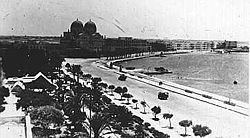 It was in 1578 that the Turks invaded Benghazi and it was ruled from Tripoli by the Karamanlis from 1711-1835, then it passed under direct Ottoman rule until 1911. Under Ottoman rule, Benghazi was the most impoverished of the Ottoman provinces. It had neither a paved road nor telegraph service, and the harbor was too silted to permit the access of shipping. Greek and Italian sponge fishermen worked its coastal waters. In 1858, and again in 1874, Benghazi was devastated by bubonic plague. It was in 1578 that the Turks invaded Benghazi and it was ruled from Tripoli by the Karamanlis from 1711-1835, then it passed under direct Ottoman rule until 1911. Under Ottoman rule, Benghazi was the most impoverished of the Ottoman provinces. It had neither a paved road nor telegraph service, and the harbor was too silted to permit the access of shipping. Greek and Italian sponge fishermen worked its coastal waters. In 1858, and again in 1874, Benghazi was devastated by bubonic plague.
In 1911, Benghazi was invaded by the Italians. The local population of Cyrenaica under the leadership of Omar Mukhtar resisted the Italian occupation. Cyrenaica suffered ruthless oppression, particularly under the fascist dictator Mussolini. About 125,000 Libyans were forced into concentration camps, about two-thirds of whom perished. Heavily bombed in World War II, Benghazi was later rebuilt with the country's newly found oil wealth as a gleaming showpiece of modern Libya.
On 15 April 1986 US Airforce and Navy planes bombed Benghazi and Tripoli. President Ronald Reagan justified the attacks by claiming Libya was responsible for terrorism directed at the USA, including the bombing of La Belle discotheque in West Berlin ten days before.
Geography
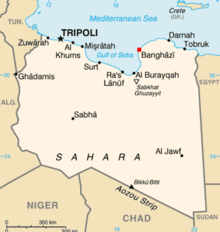
Benghazi's location within Libya |
Benghazi is one of the sub-regions of the area referred to as Cyrenaica, the others being the Jabal Akhdar and the coastal plain running east of Apollonia. Cyrenaica is surrounded by desert on three sides, hence in ancient times the most accessible civilisation was to the North, across the Mediterranean, in Crete and Greece, only 400 km away.
Benghazi is surrounded by the 'barr', arid steppe. The Jabal Akhdar, literally, 'the Green Mountain', just north of Benghazi, rises to the east. Here the vegetation and climate is more Mediterranean in feel with none of the desert landscapes found further south. A large section of the western Jabal Akhdar is taken up by the fertile Al Marj plain. Further east is the second level of the Jabal Akhdar, between 500 m and over 875 m above sea level, often thickly wooded and cut by ravines. Annual rainfall here, especially around Cyrene, can reach 500 mm. It was this fertile site northeast of Benghazi that the Greeks chose for their settlement. The soil in Benghazi is a rich red colour and very clayey.
To the north, below the steep cliffs of the plateau, lies a narrow belt of Mediterranean farmland. Olives and other mediterrenean fruits and vegetables are grown here. To the south, the forest and farmland gives way to juniper bush maquis and pre-desert scrub with some winter grazing.
As a municipality, Benghazi borders Al Hizam Al Akhdar, which surrounds it on land.
Economy
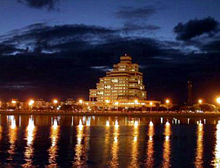
Al Daawa al-Islamiyah (The Islamic Call) building is where many of the larger companies in Benghazi have their office headquarters.
|
Benghazi is one of Libya's major economic centres. It is the country's second city and principal city of Eastern Libya. Benghazi is also a bustling port and commercial centre.
Major manufactured goods include processed food, textiles and construction materials, particularly cement; a large cement factory can be found in the Hawari district. Finance is also important to the city's economy with the Libyan Bank of Commerce and Development maintaining a branch in Benghazi. Other large banks include the Central Bank of Libya office in the city centre as well as others. Handicrafts are of little significance to the economy and are found in the many souks in the city. Tourism is still in its very early stages in Libya. The majority of tourists coming to Eastern Libya use Benghazi as a base for which to explore the Greek ruins in Cyrene or desert excursions south to Kufra. The two main hotels in the city are the Tibesti Hotel and Uzu Hotel.
A good connection of speedways and flyovers were built by Skanska in the decades after the revolution and this has made the transport of goods between Benghazi and other cities easier. Air transport from the city is via Benina International Airport with numerous daily flights to the capital Tripoli and connections to other African, Asian and European cities.
Demographics
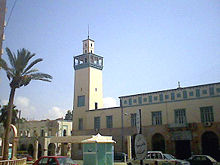
The former University of Libya
(Al-Jami'a al-Libiya) |
As with other cities of Libya, there is a reasonable amount of ethnic diversity in Benghazi. The people of eastern Libya, Benghazi included, have in the past always been of predominantly Arab descent. In recent times, however, there has been an influx of African immigrants into Benghazi. There are also many Egyptian immigrants in Benghazi because Benghazi is very close to Egypt and Sudan and enjoys a stronger economy than those countries do. Libya's Greek community is also concentrated in Benghazi largely due to distance. The Greek island of Crete is a short distance from Benghazi and many families in Benghazi today bear Cretian surnames. The predominant religion in Benghazi is Islam although there is a small Greek Orthodox church found in the centre of the city that serves Benghazi's Greek community. For those of whom who are Egyptian Copts, there is a Coptic Orthodox church in Benghazi's Coptic community, which has two priests. For Muslims, there are many mosques in and around the medina, including the Atiq and Osman mosques as well as others.
The Sa'ada tribe from the Beni salim migrated to Cyrenaica in the 11th century, each sub tribe from the Sa'adi control a territory across the state, benghazi and its surrounding area is controlled by the Awaqir and Barghathi tribe, however Benghazi has seen a lot of Libyans move into the city since the time of the kingdom, most of which arrived from Misrata.
Education in Benghazi, as is throughout Libya, is compulsory and free. Compulsory education continues up until ninth grade. There are many public primary and secondary schools scattered throughout the city as well as some private and international schools. University education is also free for all Libyan citizens in Benghazi. The largest university, Garyounis University, was founded in 1955. The country's largest library containing over 300,000 volumes is affiliated with the University. Benghazi is also home to the country's first university, the former Al-Jami'a al-Libiya.
References
- Libya: Benghazi; a Beautiful Libyan City
- Benghazi
|
|
|
|
|
|

